Technical characteristics. Usage impressions.
Dosimeter DKS-04 – Soviet professional “post- Chornobyl” dosimeter, produced in a body similar to household dosimeter “Bella”. But, if the range of colours of “Bella” was enough broad, DKS-04 produced only in red colour body. In addition, do not be confuse by low quality plastic body, its bright red “toy” colour and resemblance to his “household younger brother” – Dosimeter DKS-04 is really a professional device with serious performance capabilities.
Dosimeter DKS-04
About the appearance and quality of workmanship of the body I have written above, and there is nothing to add – it's low, but it is quite usual for the 80–90s of the last century. Unlike “Bella”, the battery compartment of DKS-04 is smaller and usual 9V battery 6F22 could not fit there. Only assembled in a special container battery of 7 pieces of Ni-Cd accumulators D-0,1 can. Obviously, this is done intentionally, so user, who uses a 9V 6F22 battery, could not accidentally put the device into the charger. However, delivery set goes with external container for a 9V battery (though I did not have such).
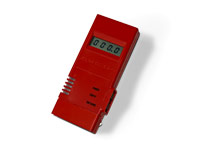 |
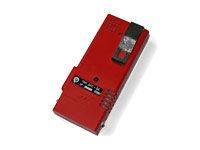 |
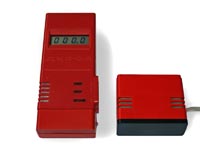 |
There are three controls and they are similar to “Bella”: the power switch, sound alarm switch (“Search” mode), the power control button, which, in contrast to “Bella”, also displays the cumulative dose – ED. On this the similarities between the DKS-04 and “Bella” ends. As I wrote, despite the same body and controls, inside these are different devices with different capabilities.
Dosimeter DKS-04 uses a miniature gas-discharge detector SBM-21 with cadmium compensating screen. Due to its size it has a low sensitivity, but wider, than in the popular GMS-20, registration range of gamma radiation power. Related to this there is another very important point: the minimum detectable level of EDR of the device – 0.1 mR/hr (100 mkR/h). Very often amateurs who bought this device on the occasion, has doubts about its work: “Bought this, turn on – but it shows all zeroes, it probably broken...” Of course, this is possible, the device made more than 20 years ago, but rather it just simply has nothing to measure. It was not designing to measure the natural, usual for most places on our planet, gamma background of 10–25 mkR/h.
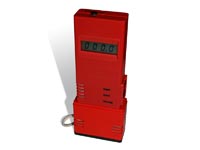 |
 |
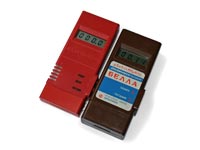 |
Dosimeter DKS-04 is intended for:
- Dosimeter DKS-04 is intended for the detection and evaluation of thermal neutron flux density, X-ray, gamma and hard beta radiation, and to measure the power of exposure dose of X-ray and gamma radiation.
- Dosimeter DKS-04 is used for individual radiation monitoring in laboratories of research institutes and various enterprises in jobs related to ionizing radiation.
- For a power supply dosimeter uses D-0,1 battery type. Charging of batteries made from the charger, which included with the dosimeter. It is also possible to connect external battery 7D-0,1 type or batteries “6F22” type. For connecting these power sources with dosimeter in delivery set included a coupler.
Features of DKS-04 dosimeter:
- Built-in Geiger-Muller detector;
- Audio alarm of each gamma-quantum and exceeding of thresholds levels;
- 4096 thresholds levels of alarm of accumulated ED, with a discreteness – 1mR;
- The presence of the LED display indication of power supply discharge.
|
mR/h
|
0,1…999,9
|
|
mR
|
1 - 4096
|
|
%
|
25
|
|
MeV
|
0,05…3,0
|
|
hour
|
8
|
|
kg
|
0,25
|
|
°С
|
+10…+35
|
|
mm
|
36×66×147
|
The first impression of the device work: speed (exposure time takes only 3 seconds, another 3 seconds to display the result, then reset and the next measurement cycle) and low sensitivity (which can be expected, given the device uses the detector SBM-21).
According to equipment certificate the device is designed to work at above-zero temperature (starting from +15оС). However, my specimen even at zero temperatures worked without problems. Some inconvenience causes by poor contact with the battery. I had to bend the battery compartment pins to maximum, but it did not solve the problem completely.
The device does not respond well on beta and low-energy gamma rays, such as from 241Am, but it reliably measures the middle and high-energy gamma from 137Cs or 60Co.
It was interesting to check whether the device has some “special” display, in case of exceeding the maximum EDR level – no, it has nothing like that. Simply counter overflow occurs: 999.9 mR/h and counting starts from zero (see bottom left photo).
 What do I like: high measurement speed, wide EDR measuring range up to 1 R/h, possibility to count obtained ED.
What do I like: high measurement speed, wide EDR measuring range up to 1 R/h, possibility to count obtained ED.
 What I do not like: low sensitivity, the inability to operate at low temperatures, short working time of the regular battery, failure to install into the device the 9V battery 6F22, low quality body.
What I do not like: low sensitivity, the inability to operate at low temperatures, short working time of the regular battery, failure to install into the device the 9V battery 6F22, low quality body.
The summary.
From the devices, which I had tested – this one least of all can be used in everyday life. However, developers did not set such goal. Everything in this device, except perhaps questionable body quality, speaks about its professional purpose. Yes, it's not search and multi-purpose device. This is personal dosimeter meant for some serious levels of gamma radiation. It is also obvious, that dosimeter DKS-04 was developed in the post-Chornobyl turmoil at decline of the Soviet era. That was a time when developers made all possible economies: on the body (several devices in one typical body) and on the detector (in fact they could use SBM-20 + SI3BG and thus provide a measuring range of tens of mkR/h up to hundreds of R/h )...
Nevertheless, the dosimeter DKS-04, released two years after the Chornobyl accident, has been operating for 25 years and it is more important for me than all the technical characteristics together.
According to my personal 10-point scale, I give 7 points to devise.
|
Dosimeter DKS-04 in EDR measurement mode – 1 R/h |
Dosimeter DKS-04 in ED display mode – 270 mR |
DKS-04 and Gamma Scout |
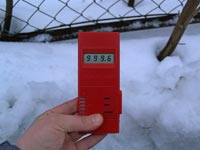 |
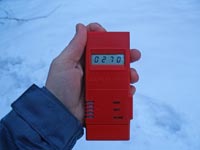 |
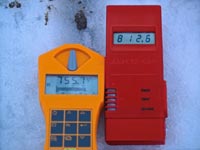 |
The device received as a gift from Alexey “August” Aguzarov. Alex, thank you very much!
Author: Yevgen «KRANZ» Goncharenko
| Next >The “Gamma Sapiens” intellectual gamma radiation detector |
|---|









